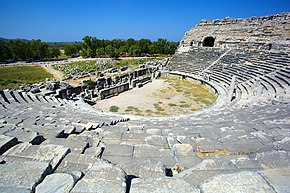Miletus
| Μί̄λητος Milet |
|

The theater of Miletus
|
|
| Location | Balat, Didim, Aydın Province, Turkey |
|---|---|
| Region | Caria |
| Coordinates | 37°31′49″N 27°16′42″E / 37.53028°N 27.27833°ECoordinates: 37°31′49″N 27°16′42″E / 37.53028°N 27.27833°E |
| Type | Settlement |
| Area | 90 ha (220 acres) |
| History | |
| Builder | Minoans (later Mycenaeans) on site of the Luwian or Carian city |
| Site notes | |
| Public access | Yes |
| Website | Miletus Archaeological Site |
Miletus (/maɪˈliːtəs/; Ancient Greek: Μί̄λητος Mīlētos; Hittite transcription Millawanda or Milawata (exonyms); Latin: Miletus; Turkish: Milet) was an ancient Greek city on the western coast of Anatolia, near the mouth of the Maeander River in ancient Caria. Its ruins are located near the modern village of Balat in Aydın Province, Turkey. Before the Persian invasion in the middle of the 6th century BC, Miletus was considered the greatest and wealthiest of Greek cities. In other sources however it is mentioned that the city was much more modest up until the Peloponnesian War (431–404 BC), when, for example, the city state of Samos on the island of Samos opposite Miletus was considered a larger and more important city and harbor at the time. Miletus' greatest wealth and splendor was reached during the Hellenistic era (323–30 BC) and later Roman times.
Evidence of first settlement at the site has been made inaccessible by the rise of sea level and deposition of sediments from the Maeander. The first available evidence is of the Neolithic. In the early and middle Bronze age the settlement came under Minoan influence. Legend has it that an influx of Cretans occurred displacing the indigenous Leleges. The site was renamed Miletus after a place in Crete.
...
Wikipedia

